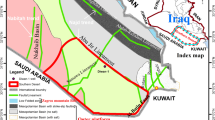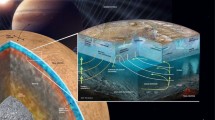Abstract
This paper considers the method of interpretation of, and results from, magnetotelluric soundings when integrated with data from magnetometry, gravimetry, and other geological and geophysical data. Stress is placed on incorporating the shift effect and the 3-D coast effect, which was studied in tentative models using numerical modeling of the magnetotelluric field. The interpretation is based on longitudinal curves, which are less subject to distortions at low frequencies. Transverse curves were used to obtain more accurate resistivities in the upper section and to identify faults. Longitudinal MTS curves were inverted to derive a geoelectric section that characterizes the resistivities in the sedimentary-volcanogenic cover and in the underlying rocks. The Earth’s crust contains a conductive layer that lies at varying depths, between 30 and 15 km. We discuss a possible origin for crustal resistivity anomalies and their possible relationship to ore occurrences at the ground surface.
Similar content being viewed by others
References
Bahr, K., Interpretation of magnetotelluric impedance tensor: regional, induction and local telluric distortion, J. Geophys., 1988, vol. 62, pp. 119–127.
Belousov, V.V., Zemnaya kora i verkhnyaya mantiya materikov (The Continental Crust and Upper Mantle), Moscow: Nedra, 1982.
Berdichevskii, M.N. and Dmitriev, V.I., Modeli i metody magnitotelluriki (The Models and Methods in Magnetotellurics), Moscow: Nauchnyi Mir, 2009.
Fyfe, W.S., Price, N.J., and Thompson, A.B., Fluids in the Earth’s Crust: Their Significance in Metamorphic, Tectonic and Chemical Transport Processes, Amsterdam: Elsevier, 1978.
Geologiya SSSR. Kamchatka, Kuril’skie I Komandorskie ostrova. Geologicheskoe opisanie (The Geology of the USSR. Kamchatka, Kuril Is., and the Commander Is.: A Geological Description), vol. 31, Moscow: Nedra, 1964.
Karta poleznykh iskopaemykh Kamchatskoi oblasti masshtaba 1: 500000 (A Map of Mineral Deposits for Kamchatka Region to Scale 1: 500000), Litvinov, A.F. Patoka, M.G., and Markovskii, B.A., Eds., St. Petersburg: VSEGEI, 1999.
Lander, A.V., Levina, V.I., and Ivanova, E.I., The earthquake history of the Koryak Upland and the aftershock process, J. Volcanol. Seismol., 2010, vol. 4, no. 2, pp. 87–100.
Mackie, K.L., Smith, J.T., and Madden, T.R., Threedimensional electromagnetic modeling using finite difference equations: the magnetotelluric example, Radio Science, 1994, no. 4, pp. 923–935.
Moroz, Yu.F., Results of studies of eastern Kamchatka using integrated TT, MTS, and VES electrical prospecting techniques, Geologiya i Geofizika, 1976, no. 10, 140–144.
Moroz, Yu.F., Elektroprovodnost’ zemnoi kory i verkhnei mantii Kamchatki (The Electric Conductivity of the Crust and Upper Mantle in Kamchatka), Moscow; Nauka, 1991.
Nurmukhamedov, A.G. and Moroz, Yu.F., Deep structure of the northeastern Koryak-Kamchatka folded area: Evidence from regional geophysical surveys, Geofizicheskii Zhurnal, 2009, vol. 31, no. 3, pp. 1–10.
Ravich, M.I., Phase equilibria in some water-salt systems at high temperatures and pressures, in Eksperimental’noe modleirovanie prirodnykh protsessov (Experimental Simulation of natural Processes), Moscow: nauka, 1971, pp. 112–118.
Rivosh, L.A., A geomagnetic characterization of major tectonic features in the eastern USSR in the transition zone between the Asian continent and the Pacific Ocean, and in the abyssal Pacific seafloor, Geologuya i Geofizika, 1964, no. 5, pp. 38–51.
Smirnov, Ya.B. and Sugrobov, V.M., Terrestrial Heat Flow in the Kuril-Kamchatka and Aleutian Provinces. 1. Heat Flow and Tectonics, Vulkanol. Seismol., 1979, no. 1, pp. 59–73.
Swift, C.M., A Magnetotelluric Investigation of an Electrical Conductivity Anomaly in the Southwestern United States, Ph. D. Dissertation, MIT, Cambridge, 1967, 248 pp.
Van’yan, L.L. and Khaidman, R.D., On the origin of electrical conductivity in the consolidated crust, Fizika Zemli, 1996, no. 4, pp. 5–11.
Author information
Authors and Affiliations
Corresponding author
Additional information
Original Russian Text © Yu.F. Moroz, O.M. Samoilova, T.A. Moroz, 2015, published in Vulkanologiya i Seismologiya, 2015, No. 2, pp. 65–80.
Rights and permissions
About this article
Cite this article
Moroz, Y.F., Samoilova, O.M. & Moroz, T.A. Electric conductivity at depth: The southern coast of north Kamchatka. J. Volcanolog. Seismol. 9, 125–139 (2015). https://doi.org/10.1134/S0742046315020062
Received:
Published:
Issue Date:
DOI: https://doi.org/10.1134/S0742046315020062




